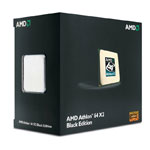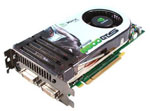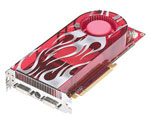AMD Midrange Gaming
Let's start by pointing out the pink elephant hiding in the corner: there's no doubt that Intel has faster processors than anything AMD is currently shipping. Intel also has CPUs that overclock (percentage wise) a lot better than anything AMD currently offers. So why even bother considering AMD? There are several reasons. Price is the biggest attraction, which extends beyond the price of the CPU to the price of the platform as a whole. The other major consideration is that if you're talking about a gaming system, for the vast majority of systems the graphics card is going to be the most important aspect of gaming performance. The features you can get at a particular price point for an AMD setup are also very good. Now that that's out of the way....
| AMD Midrange Gaming System |
| Hardware |
Component |
Price |
Rebates |
| Processor |
Athlon 64 X2 5000+ AM2 Black Edition (2.6GHz 2x512K unlocked) - Retail |
$130 |
|
| Motherboard |
ASUS M2N32-SLI Deluxe WiFi (nForce 590 SLI) |
$167 |
|
| Memory |
Patriot Extreme Performance 2x1GB PC2-8500 (PDC22G8500ELK) |
$139 |
$25 |
| Video Card |
XFX GeForce 8800GTS 320MB (PVT80GGHF4) |
$287 |
$20 |
| Hard Drive |
Western Digital Caviar SE16 320GB 7200RPM 16MB (WD3200AAKS) |
$80 |
|
| Optical Drive |
Samsung 20X DVD+R SATA (SH-S203B) |
$36 |
|
| Case |
Cooler Master Centurion 534 (RC-534-KKN2-GP) |
$66 |
$10 |
| Power Supply |
Corsair CMPSU-520HX |
$108 |
$10 |
| Display |
Acer AL2216Wbd 22" 5ms (1680x1050) |
$235 |
|
| Speakers |
Logitech X-530 5.1 70W Speakers |
$66 |
|
| Keyboard |
Saitek Eclipse USB Wired (PZ30AU) |
$40 |
|
| Mouse |
Logitech G5 Wired Adjustable Weight |
$52 |
$15 |
| Operating System |
Windows Vista Home Premium 32-bit (OEM) |
$105 |
|
| Bottom Line |
$1511 |
$1431 |
 |
The core of any system is the motherboard and processor, and we've gone with AMD's latest X2 5000+ Black Edition sitting snugly in an ASUS M2N32-SLI Deluxe WiFi motherboard. The Black Edition's claim to fame of course is its unlocked multiplier, giving overclockers a little bit more flexibility. We've seen reports online of people hitting 3.4 GHz and beyond with a bit of effort. While just about any midrange Core 2 Duo processor will offer better performance at maximum stable overclock, the X2 5000+ is still relatively inexpensive and offers competitive stock performance. If you don't care about the unlocked multiplier, a regular X2 5000+ costs $10 less.
If you're undecided on what CPU or platform might be best, you might want to take a look at our
Midrange CPU Roundup from a couple weeks back. As long as you're willing to take overclocking out of the picture, you can get performance that's relatively competitive with Intel's Core 2 Duo E4400/E4500 with a CPU price that's nearly identical to the E4400 - or about $13 cheaper if you get the standard 5000+. Looking specifically at the gaming results from that article, performance tends to fall between those same two processors, at least at 1024x768 where we aren't GPU limited. If you're like most people and you plan to play at higher resolutions (for example 1680x1050 if you purchase the recommended LCD), performance differences are going to be even smaller.
 |
The ASUS motherboard offers SLI support, which might be something useful in the future, but for a midrange system we're going to stick with single graphics cards for now. The ASUS M2N32 Deluxe WiFi also comes with a bevy of overclocking options, ASUS' proven reputation, and integrated 802.11b/g WiFi support for good measure. If you will make use of all of these features, the final price is very good; if you don't need WiFi or dual x16 PEG slots, you can get basically the same performance and features for around $95 with the DFI Infinity NF570-M2/G.
As mentioned, the graphics card is probably the most important component for this type of system, and we had quite a few choices. We decided to go with a GeForce 8800 GTS 320MB, as it offers the most attractive price/performance ratio. Other than minor differences in factory clock speeds, all of the 8800 GTS cards are pretty similar, so the deciding factor was price. XFX ended up getting the nod, but EVGA, Gigabyte, Leadtek, and others are not too far off.
 |
It's important to point out the runner-up cards that we didn't choose as well, as other factors might actually make them a better choice in the long-run. The 8800 GTS 320MB performs identically to the 640MB version, up until the point where you run out of graphics memory. Right now, that usually only happens at extreme resolutions like 2560x1600 or in a few certain games with maximum texture quality (which often doesn't bring a noticeable improvement in visual quality). That's right now, however; next-generation games could very likely push 320MB cards to the limit, particularly when we consider that 512MB cards have been shipping for a couple of years now. We have seen preliminary results on next-gen titles where the 640MB cards hold a pretty substantial performance advantage, so if you can spare the extra money that's probably the safer bet.
 |
The other option is AMD's recently launched HD 2900 Pro, which in theory carries a similar price to the 8800 GTS 320MB. The drawback here is that the cards aren't readily available right now, and while this is an AMD platform we're using an NVIDIA chipset. MSRP is supposed to be around $250, but the few places that even have cards in stock are charging a price premium. Since the cards seem to be downclocked 2900 XT GPUs, you can probably get some pretty good overclocking results, but many people are simply interested in stock performance. You also get a $20 mail-in rebate on the GTS 320MB, and HD 2900 cards tend to really suffer when antialiasing is enabled. Finally, AMD and NVIDIA both have upcoming midrange cards that could very well improve performance while staying under the $250 price point; since these cards are not yet available, however, they will have to wait for a future Buyers' Guide.
 |
We're not going to spend a lot of time dwelling on the rest of the components, as many of them have been discussed in previous Buyers' Guides and/or reviews. We did choose to use some DDR2-1066 memory, which honestly might be overkill considering the price. $114 (after rebate) for 2GB of this type of memory might seem like a steal compared to a year ago, but if you're okay with DDR2-800 you can still pick up 2GB of 4-4-4 memory for a measly $75. In fact, one of the AnandTech editors did exactly that just this last week... twice! If you're thinking about upgrading to a 64-bit operating system, give some serious thought to running a 4GB configuration with DDR2-800 as opposed to 2GB of higher performance DDR2-1066.
The final price comes out to $1511 (not counting rebates). Depending on how you want to configure things, going with an AMD platform will save you somewhere between $15 and $100 compared to a similar Intel configuration. By no means is our AMD platform bad, but if we were to go out and purchase a midrange gaming system right now, it would be using a Core 2 Duo processor. Then again, we're enthusiasts, so overclocking is pretty much a given. If you can hold on a couple more months, we're definitely interested in some of the changes that will occur with AMD's upcoming product launches. The attraction of current AM2 systems is mostly price, and the gap there is really too small these days to make it a real deciding factor.















41 Comments
View All Comments
jonp - Thursday, October 18, 2007 - link
I would like to propose an alternative to both the Cooler Master Centurion 534 and the Lian Li PC-7B plus II: the Thermaltake Swing VB6000BNS/VB6000BWS (both available at Newegg $60/$67). This mid-tower case has:4 5.25" ext drive bays
2 3.5" ext drive bays
4 3.5" int drive bays (facing the case side for easy access)
0.8mm SECC steel except for the black plastic case front
Tool-free design with side cover thumb screws
12cm rear fan - included
12cm front fan
7 expansion slots
Room for a standard ATX motherboard.
Plastic fan brackets for easy fan install/removal.
Washable front dust filter.
BNS - no side window, BWS - side window
The case USB, 1394 and audio ports are on the top of case front along with one 3.5" ext drive bay. The is very convenient since all of my systems sit on the floor (noise, weight, desk space, etc).
Front power and reset buttons.
No power supply so you can choose your own.
Also I think the design in Piano black is both professional and attractive.
yyrkoon - Wednesday, October 17, 2007 - link
Who says you need a 64BIT OS to use 4GB of RAM ? Until I had to RMA a pair of 1GB sticks, I was using 4GB with WinXP x32. Photoshop ran faster, applications opened and closed much faster, and my system in general operated much smoother. I tried the /3GB switch, and no joy as it would cause random BSoDs, and in the end, I just let the default /NOEXECUTE=optin switch deal with /PAE for me, and I had 3.5GB of RAM availible to applications/processes. Was it a huge performance gain ? No, but it was well worth the ~$80 usd before MiR.
Remember, your system does not operate in a vacuum, it need memory to be effective. At the same time, programs like Photoshop that can make use of up 2.5GB of RAM just for the executable can benifit from having 2GB dedicated soley for its use. With 3.5GB availible I was able to allow Photoshop to use 100% memory(~2GB without the /3GB switch in use), and had 1.5GB for the system, and anything else I wanted to run at the same time.
So in short of using a 64BIT OS, it was a perfect solution that gave me plenty of speed increase for the money spent. A much better option that spending ~110 for 2GB of RAM, that is truely too much for the given system.
JarredWalton - Wednesday, October 17, 2007 - link
Apparently there's an abundance of people that feel "think about upgrading to a 64-bit OS" means the same thing as "you absolutely MUST upgrade to a 64-bit OS". See above commentary. Personally, when I finally switch my work system to Vista, it will be for Vista 64-bit. Because if I'm going to take the Vista plunge, I'm going to take the 64-bit plunge as well and hopefully be better prepared for future applications and memory requirements.Is it 100% necessary? Nope. But if someone asked me for my opinion on the matter, I'd advise them to give some serious thought to running Vista x64. Maybe in another year or two, we'll even start to truly see a need for it in more applications.
yyrkoon - Wednesday, October 17, 2007 - link
That really has little to do with what I was saying. Mainly, my point has to do with your choice of RAM. You will most likely see a much more noticable performance gain using 4GB of RAM in XP, than using 2GB of high performance RAM(even overclocked). For instance, overclocking my AM2 1210 CPU, and looking for noticable performance gains, I do not notice any without diving into a battery of benchmarks. This also includes having run the memory 100MHZ over spec(900MHZ DDR2). I do agree with your article comments concerning 1066DDR2 memory could help your high overclock possiblities. Since Vista is a resource hog by comparrison, I am sure it would be far more benificial to run as more memory as possible as well.
Hey, I hear nothing but good things about Vista x64, but when I upgrade to Vista, it will be to Ultimate retail, and I will most probably at least start off with x64. IF it works out good, then I will stay. The problem is not all the ordinary applications I run that I am worried about, its the games that I play in my down time. Also when I make that leap, my costs will probably be higher than the average upgrader, as I plan on running 8GB of RAM.
Anyhow, for what its worth, Photoshop CS3, Lightroom, Nikon Capture NX, and several other RAW/image editing applications are supposed to run very well, and fast on Vista x64. At least this seems to be the general consensus with every dpreview photographers/image re-touchers that I have spoken to concerning the topic.
JarredWalton - Wednesday, October 17, 2007 - link
If there were a native 64-bit Photoshop version out, I'd already be running Vista x64 with 8GB of RAM. (Curse you Adobe....) :)Isn't what you said what I put in the article, more or less? We selected DDR2-1066, but it might not be necessary depending on what you want to do with the system. 4x1GB DDR2-800 (or 2x2GB) and x64 is a very viable alternative. Which one you take depends on your end goal. Overclockers and tweakers will likely prefer DDR2-1066; more typical users that run a lot of memory intensive apps will be well-served by running 4GB of RAM. People looking for some cost savings that don't intend to push for maximum overclocks can happily run DDR2-800.
Panther - Wednesday, October 17, 2007 - link
Great guide Jarred.I've been meaning to build a new workstation so the timing of this article is perfect!
One question though, is there any Nvidia card you'd recommend in lieu of the 2600XT which provides a similar performance profile? I'm going to run linux and would rather avoid ATi just based on my last experience (granted it's been almost three years ago) trying to use ATi's linux drivers.
JarredWalton - Wednesday, October 17, 2007 - link
8600 GT and 8600 GTS cards are also reasonable choices. I have one that includes two dual-link DVI outputs, even. I suppose GPU choice is going to be impacted by how you're planning on using it. The 2600 XT is a pretty decent GPU, but in Linux and in games the 8600 GTS probably is a better choice. For video decoding (H.264) I think it beats the 8600 cards, but that's not really a huge concern for most workstations. The only concern is that the 512MB 8600 cards cost quite a bit more than the 512MB 2600 XT listed. So you can give up 256MB of GPU RAM or spend more money.I'm going to edit the GPU section on the workstation slightly, though, as you do make a valid point.
leexgx - Friday, October 19, 2007 - link
not sure about the 8800 but the 8600 and lower cards i think have some driver supporti going to be putting k/ubuntu 7.10 onto an 80gb hdd to see if all my hardware works
Kishkumen - Wednesday, October 17, 2007 - link
"...thinking about upgrading to a 64-bit operating system, give some serious thought to running a 4GB configuration"Um, why do you need to upgrade to a 64 bit operating system just to use 4GB of memory? Something is seriously wrong there. My 32bit operating system can use 4GB just fine. Even up 64GB I think. It is Linux... but I know a tech savvy site like Anandtech wouldn't make some sort of generalization that "operating system" automatically means some version of Microsoft's NT operating system would it? I mean we are open to different technologies around here aren't we? I wonder sometimes... Well, that's OK, I still like your hardware recommendations anyway.
JarredWalton - Wednesday, October 17, 2007 - link
A standard desktop PC can't run let alone address 64GB of memory. Unless you're hiding the unbuffered 16GB DDR2 modules from the rest of us? I take it you're referring to 32-bit servers running PAE in order to access more than 4GB of RAM. Or are you referring to a large swap file (which isn't actually RAM)? Both are possible, but obviously for the general computing market it's not an important topic for discussion.I can't say that I run Linux on a regular basis anymore, but there are ways to work around memory limitations. Given the target audience of our Buyer's Guides, running off into tangents about various memory management theories doesn't seem to be particularly useful. For those that prefer to stick with Windows, pretty much the only way you're getting full use of 4GB of memory or more is with a 64-bit version of the OS.
Generally speaking, however, the BIOS and motherboard will limit your options. 4GB is now usually reasonable - in 32-bit Windows Vista you'll usually get access to around 3GB of memory - but while 8GB is theoretically supported on most modern motherboards, compatibility is still sketchy. I'd look up motherboard compatibility charts from the manufacturer and make sure to get approved modules if you want to do a 4x2GB setup.